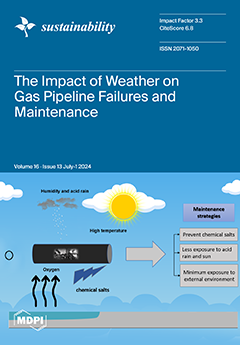Biochar application is considered an effective method for reducing nitrous oxide (N
2O) emissions from soil. However, the mechanisms underlying the influence of various biochar dosages on soil N
2O emissions and the duration of one-time biochar application remain unclear. The
[...] Read more.
Biochar application is considered an effective method for reducing nitrous oxide (N
2O) emissions from soil. However, the mechanisms underlying the influence of various biochar dosages on soil N
2O emissions and the duration of one-time biochar application remain unclear. The effects of different biochar application rates and a one-time application on soil N
2O emissions in the Huanghuaihai Plain of China were investigated through a field experiment from 2020 to 2022. In the wheat and maize rotation system, six treatments were administered: no biochar (C0); 2 (C1), 4 (C2), 8 (C3), and 12 t/hm
2 biochar (C4) applied annually; and a one-time application of 12 t/hm
2 biochar (CS) in 2018. Our results indicate that, compared with C0, biochar significantly inhibited soil N
2O emissions, particularly in the C3 and C4 treatments, with reductions of 31.36–56.21% and 36.92–52.45%, respectively. However, CS did not significantly affect soil N
2O emissions during the study period. These findings suggest that the biochar’s inhibitory effect on soil N
2O emissions is contingent upon the dosage and frequency of application. A structural equation model revealed that biochar decreases soil N
2O emissions by enhancing the reduction in N
2O during denitrification. Under the conditions of this experiment, based on a logistic ecological model, a one-time application of 12 t/hm
2 biochar was projected to significantly reduce soil N
2O emissions for approximately 1.77 years. On the whole, biochar reduces soil N
2O emissions mainly by regulating N
2O production through denitrification, and the duration of this inhibition of N
2O emissions mainly depends on the application amount and frequency of biochar application.
Full article





